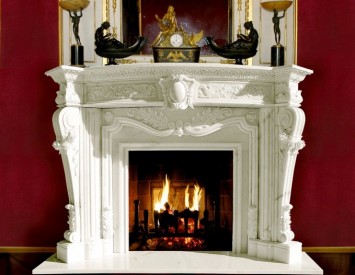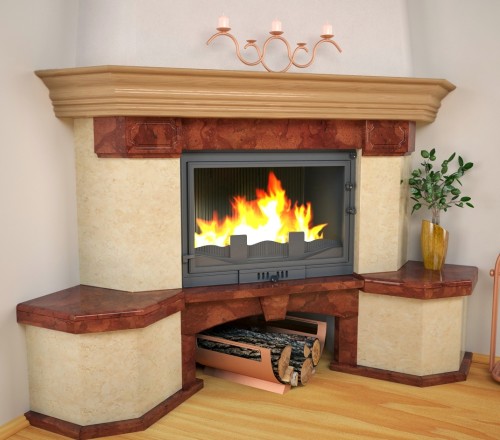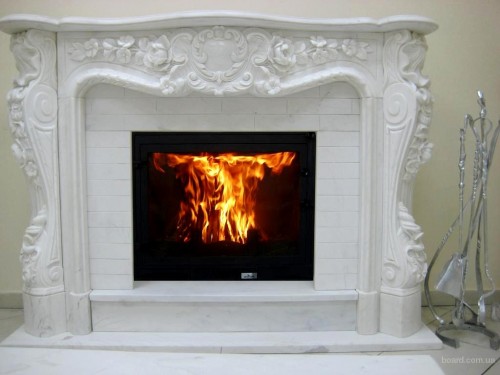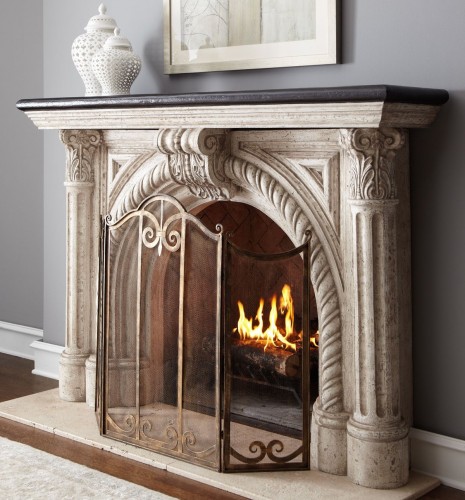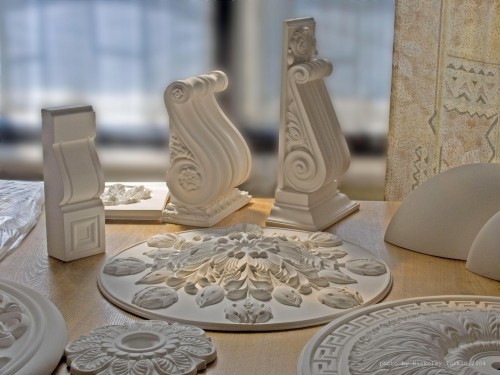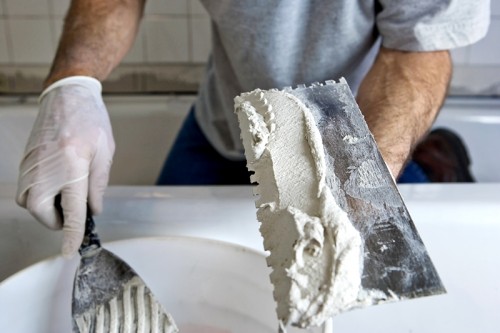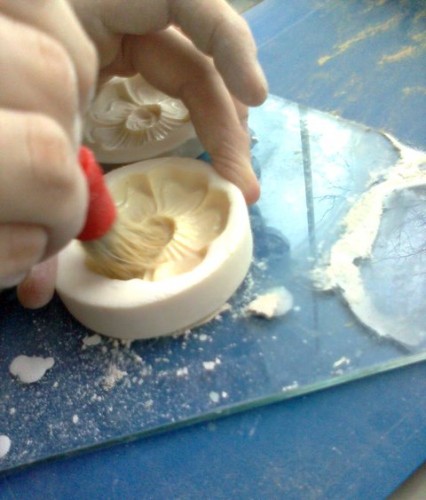The fireplace in a modern interior is a central design element of almost any room. For this reason, its decoration is considered no less important component than the functional responsibilities of the device. Succinite for a gypsum fireplace is an optimal solution for creating an individual style in the interior that will help decorate living space.
Content
Choosing stucco decoration
The initial stage when choosing a decorative stucco on the fireplace is the determination of the type and cladding of the hearth itself, as well as its characteristics and features of operation.
According to the criterion of the fuel used today, there are two types of fireplaces:
- The focus of the electric type is a fireplace imitating a real flame. This effect is achieved by means of the burner equipped inside the heater and created by the burning of logs: regulation of the brightness of fire, the effect of crackling coal and firewood, the backlighting of coal and logs, etc.
- A fireplace with natural fire is a focus of natural formation, for which natural materials, liquid or biological fuel are fuel.
When planning the options for the focus of gypsum, these features must be taken into account, since the appearance of soot, soot and other traces of use directly in the decorated stucco molding.
One of the main elements where gypsum stucco molding is applied to the fireplace , The fireplace opening is directly. This design does not carry a functional load, but performs an exclusively aesthetic role in the facing of the hearth. Based on this feature, the main task when decorating the fireplace lies in the harmonious decoration of the structure with the general interior of the room and the features of its style.
Depending on the technology of production of gypsum fireplaces, the following types can be distinguished:
- Profile - is a decoration of the portal in the form of a framing from various fragments: pilasters, frizes, molding, cut, etc.
- Sculptural - a type of decoration, when a dominant role in the composition is played by a central figure: Atlant, frescoes, bas -reliefs or cariathids.
Gypsum stucco molding is often used for facing the fireplace in various styles of architectural decor: from classic to Empire or high-tech. Let us consider in more detail the stylistic features of the design of the fireplace stucco molding.
Stucco stucco style styles for a fireplace
- Finishing the fireplace "under the stone" - gives the focus of massiveness and naturalness in the design of the decor of the room.
- Classic stucco decoration of the hearth - used to give the design of the entourage of the medieval style and spirit of antiquity.
- The lining of the fireplace for the ancient style is artificially aged fragments of decor, which fill the room with an atmosphere of comfort of the hearth, warming for more than one generation. Such fireplaces with stucco molding in the photo they are presented in diverse variations, which allows you to integrate them to any room design.
Advantages of plaster gypsum decor
- GIPS is an impeccable solution in terms of the environmental friendliness of the material and its unsaturated qualities.
- Such stucco molding has refractory characteristics, which allows you to safely use in a living room.
- Gypsum cladding is durable, does not contain toxic components and has no smell, so its use does not harm the comfort of a person near the hearth.
- This material has moisture -absorbing properties.
- Gypsum stucco molding does not conduct electric current, its decoration is safe for all family members.
How to make a stucco decoration with your own hands
When creating stucco molding from gypsum for a fireplace portal, it is necessary to take into account some features, as well as the alternity of the implementation of all stages of this process. Let us consider in more detail each step.
Choosing a form or figure
Gypsum stucco molding on the fireplace has a wide variety of shapes and styles, not limited to the formation of only floral ornaments, figures of angels or athletes supporting the shelf. Using this plastic material, you can imitate various natural materials, “grow” any plant or tree on a vertical surface. The style, shape, color scheme of the figure for facing stucco molding is limited only to the fantasy of the master.
When choosing the appearance of stucco decor, it is necessary to take into account the size of the hearth, location and type of structure.
Gypsum stucco
The simplest option for facing the focus of the hearth is just to buy stucco molding for a fireplace. Modern workshops offer a wide selection of decorative elements. However, the creation of a hand -handed masterpiece is much more valuable, moreover, this process will not be difficult.
To prepare a liquid gypsum solution, it is necessary to stir 1 kg of dry gypsum by 800 ml of water. For the substance of medium density, it is recommended to mix 1.5 kg of gypsum powder in 1 liter of water. And if it is necessary to knead a completely thick mass, then 2 kg of gypsum should be added to 1 liter of water.
If you need to form a large gypsum figure, then you should prepare the solution in small portions. Excessively thick consistency of the solution is quite problematic to pour into the form, and also does not fill fragments with a thin relief.
The formation of gypsum stucco molding
In order to arrange a stucco molding fireplace with your own hands, you need to go through several stages of the process.
- Initially, you need to apply the contour of the future composition to the surface of the fireplace. This can be done both manually and using a stencil.
- Apply a gypsum substance to the surface, evenly distributing and rubbing. Then it is necessary to remove all the extra fragments. If necessary, you can repeat the whole process.
- Apply a solution of gypsum to the location of the stucco molding.
- After the gypsum is completely dry, it is necessary to process the applied mass according to the figure and polish.
If the product has a complex and multicomponent configuration, then it is performed in a special form. In this case, a number of the following manipulations should be carried out:
- Lubricate the prepared form with a solution of water and soap abundantly.
- Pour the gypsum substance into the form in layers. The maximum permissible thickness of each layer should not exceed 1 cm.
- Each layer can only be applied after the final drying of the previous one.
- A solid product should be gently extracted from the mold.
- Fix on the fireplace structure by means of special gypsum glue.
Important! To create filigree compositions or thin reliefs in stucco molding from gypsum for a fireplace you can use plasticine. With this material, it is possible to easily and carefully choose the necessary form of the future fragment, changing its countless times. Then, a gypsum solution is applied to the prepared plasticine shape with a brush. And the formation of further layers of the composition occurs using a spatula, applying each new layer as it dries.
When creating stucco decor for the fireplace, you must adhere to the following recommendations:
- When pouring gypsum substance into the form, the occurrence of air bubbles should be avoided. This is achieved by means of light shaking the form with liquid solution, which will also ensure a thorough filling of reliefs.
- Drying gypsum figures should occur at a temperature of at least +160 ° C.
- Do not accelerate the drying process using a fan, hair dryer or heating devices, as this leads to deformation of the gypsum product.
After the formed stucco molded is dried and processed for the necessary form corresponding to the specified pattern, it is necessary to paint the gypsum element. Water -based paints are suitable for this. However, before starting staining gypsum stucco, a fragment should be impregnated with 2 layers of primer. And you can give an unusual texture of stucco decoration through the use of various materials: fabrics, sponge, etc.
If, in the process of creating a gypsum decorative element, small inaccuracies or disadvantages occur, they can be easily eliminated with a knife. After that, the product should be sanded with sandpaper with a small fraction.
The process of manufacturing stucco molding from gypsum can be seen here:
